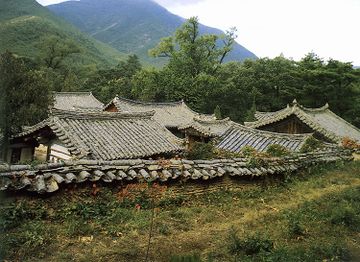경주 옥산서원
| 경주 옥산서원 Oksanseowon Confucian Academy, Gyeongju |
|
 경주 옥산서원, 국가문화유산포털, 문화재청. |
|
| 대표명칭 | 경주 옥산서원 |
|---|---|
| 영문명칭 | Oksanseowon Confucian Academy, Gyeongju |
| 한자 | 慶州 玉山書院 |
| 주소 | 경상북도 경주시 안강읍 옥산서원길 216-27 (옥산리) |
| 지정(등록) 종목 | 사적 제154호 |
| 지정(등록)일 | 1967년 3월 8일 |
| 분류 | 유적건조물/교육문화/교육기관/서원 |
| 시대 | 조선시대 |
| 수량/면적 | 95,681㎡ |
| 웹사이트 | 경주 옥산서원, 국가문화유산포털, 문화재청. |
|
|
|
해설문
국문
조선 중종 때의 문신이자 성리학자인 회재 이언적(晦齋 李彦迪, 1491~1553)의 학문과 덕행을 기리기 위해 세운 서원이다. 이언적은 조선 중기의 문신이자 유학자로 그의 학설이 이황(李滉)에게 계승되어 영남학파의 중요한 성리학설이 되었으며 조선 성리학의 한 특징을 이루었다.
선조 5년(1572)에 경주부윤 이제민이 지방 유림의 뜻에 따라 처음 세웠고, 이듬해에 옥산서원이라는 이름을 하사받아 사액서원(賜額書院)*이 되었다. 고종 5년(1868) 흥선대원군의 서원철폐령* 때에도 유지되었던 47개 서원 중의 하나이다.
서원건축으로는 초기 건축물이면서도 질서정연한 형식을 하였다. 정문인 역락문을 들어서면 무변루와 구인당, 동·서재가 강학공간을 구성하고 구인당 뒤편의 체인묘가 제향공간으로 이언적의 위패를 모시고 있다. 동재 오른쪽의 여러 건물들은 서원의 살림을 맡아보던 곳이고 그 뒤편 건물은 목판을 보관하는 곳이다. 옥산서원 현판은 아계 이산해와 추사 김정희의 글씨이다.
옥산서원은 2010년 7월에 ‘한국의 역사마을 : 하회와 양동’으로 세계유산에 등재되었고, 2019년 7월에 서원 8곳과 함께 ‘한국의 서원*’으로 다시 등재되었다.
- 사액서원(賜額書院) : 임금이 이름을 지어서 새긴 편액을 내린 서원. 흔히 서적, 토지, 노비 등도 동시에 하사하였다.
- 서원철폐령(書院撤廢令) : 조선 말기 흥선대원군이 서원을 훼철(毁撤)한 일. 전국 650개 서원 중 소수서원·도산서원·도동서원 등 47개의 서원만 남겨 놓았다.
- 한국의 서원 : 유네스코 세계유산에 등재된 서원 9곳은 영주 소수서원, 함양 남계서원, 경주 옥산서원, 안동 도산서원, 장성 필암서원, 달성 도동서원, 안동 병산서원, 정읍 무성서원, 논산 돈암서원이다.
영문
Oksanseowon Confucian Academy, Gyeongju
Confucian academies, called seowon in Korean, are private education institutions of the Joseon period (1392-1910) which usually combined the functions of a Confucian shrine and a lecture hall. Oksanseowon Confucian Academy was established in 1572 to honor the scholarship and virtue of the renowned civil official and neo-Confucian scholar Yi Eon-jeok (1491-1553).
Yi Eon-jeok passed the state examination in 1514 and served various government posts such as minister of personnel, minister of rites, and minister of punishment. In 1547, he was expelled from office during a literati purge and was exiled to Ganggye in Hamgyeongbuk-do (today’s North Korea). After this, he devoted himself to studying and teaching and also wrote important books on neo-Confucianism. His honor was posthumously reinstated in 1567. In 1610, he became one of the first five Korean sages to be commemorated at the National Confucian Shrine.
In 1573, the academy was royally chartered and bestowed its name, which means “Confucian Academy of the Jade Mountain,” in reference to the mountain to the west of the village named Jaoksan (“Mountain of the Purple Jade”). In the late 19th century, most Confucian shrines and academies were shut down by a nationwide decree, however this academy was one of the 47 that were allowed to remain standing.
The academy complex consists of a lecture area in the front and a ritual area in the back, as well as a management area to the right. The lecture area consists of a gate pavilion, two dormitories, and a lecture hall. The ritual area consists of a stele pavilion, a royal calligraphy pavilion, an inner gate, a ritual preparation hall, and a shrine. The management area consists of a management office, a custodian’s residence, a kitchen, a storehouse, a barn, and a woodblock repository.
In 2010, the academy was listed on the UNESCO World Heritage List as part of the Historic Villages of Korea: Hahoe and Andong. In 2019, it was listed again together with eight other academies as part of Seowon, Korean Neo-Confucian Academies.